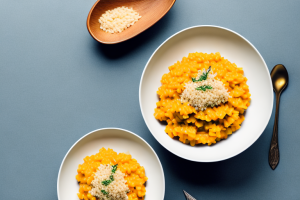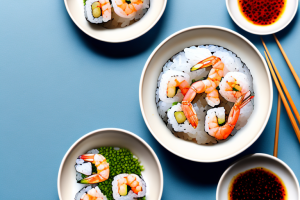How to prepare wild rice with cranberries and pecans
8 min read
A bowl of wild rice with cranberries and pecans
Are you looking for a unique side dish to impress your guests at your next dinner party? Look no further than this delicious recipe for wild rice with cranberries and pecans! Not only is it visually stunning with a beautiful mix of colors and textures, but it also boasts amazing health benefits, making it a great addition to any meal. Let’s dive into everything you need to know to prepare this dish perfectly.
The health benefits of eating wild rice, cranberries, and pecans
First and foremost, let’s talk about the amazing health benefits of these three key ingredients. Wild rice is not technically a rice grain, but rather the seed of a semi-aquatic grass. It is a great source of protein, fiber, and essential nutrients like magnesium, phosphorous, and zinc. Cranberries are packed with antioxidants and have anti-inflammatory properties, making them great for fighting infections and promoting heart health. Pecans are filled with healthy fats, fiber, and essential minerals like copper and manganese, which are important for bone health and energy production. So, not only does this dish taste great, but it’s also good for you!
Additionally, studies have shown that consuming wild rice, cranberries, and pecans can also have positive effects on brain function. Wild rice contains high levels of antioxidants, which can help protect the brain from oxidative stress and improve cognitive function. Cranberries have been found to improve memory and reduce the risk of age-related cognitive decline. Pecans contain vitamin E, which has been linked to a reduced risk of Alzheimer’s disease. So, not only are these ingredients delicious and nutritious, but they can also help keep your brain healthy and functioning at its best.
Wild rice: history and culinary uses
Wild rice has been a staple food for many Native American tribes for centuries. It grows naturally in the shallow waters of lakes and rivers in the Great Lakes regions of the United States and Canada. In traditional cooking, wild rice was often mixed with other grains like corn and beans to create nutrient-rich dishes. Today, wild rice is used in a variety of dishes, from soups and salads to pilafs and casseroles.
Wild rice is not actually a type of rice, but rather a type of grass. It is also known as “manoomin” in the Ojibwe language, which translates to “good berry.” Wild rice is high in protein, fiber, and antioxidants, making it a nutritious addition to any meal. In addition to its culinary uses, wild rice is also used in traditional medicine by some Native American tribes to treat various ailments, such as digestive issues and headaches.
Choosing the right type of wild rice for your recipe
When choosing wild rice for this recipe, look for high-quality, long-grain wild rice. It should have a nutty aroma and a slightly chewy texture when cooked. Avoid buying pre-cooked or instant wild rice, as these are often processed and lack the full flavor and texture of unprocessed wild rice.
Additionally, consider the origin of the wild rice. Wild rice grown in Minnesota, Wisconsin, and Canada is often considered the highest quality due to the cooler climate and pristine water sources. However, wild rice from California and other warmer regions can also be delicious and nutritious. If possible, try to purchase wild rice from a reputable source that provides information on the origin and processing methods.
How to cook wild rice perfectly every time
Before cooking wild rice, it’s important to rinse it thoroughly in cold water to remove any debris or impurities. Then, add the rice to a pot with three cups of water for every one cup of rice. Bring the water to a boil, then reduce the heat to low and cover the pot. Simmer for about 45 minutes to an hour, or until the rice is tender and all the water has been absorbed.
One way to add more flavor to your wild rice is to cook it in chicken or vegetable broth instead of water. This will give the rice a richer taste and make it more savory. You can also add herbs and spices, such as thyme, rosemary, or garlic, to the cooking water to infuse the rice with additional flavors.
Wild rice can be used in a variety of dishes, from salads to soups to casseroles. It pairs well with vegetables like mushrooms, carrots, and onions, as well as proteins like chicken, turkey, and tofu. You can also mix it with other grains, such as quinoa or brown rice, to create a more complex and nutritious dish.
The nutritional value of cranberries and pecans
Cranberries and pecans are both key players in this dish, providing a range of essential vitamins and minerals. Cranberries are rich in vitamin C, vitamin K, and fiber, while pecans are a great source of healthy unsaturated fats, fiber, and protein.
In addition to their nutritional benefits, cranberries have been found to have anti-inflammatory properties and may help prevent urinary tract infections. Pecans, on the other hand, have been linked to improved heart health and may help lower cholesterol levels. Incorporating these two ingredients into your diet can have a positive impact on your overall health and well-being.
The importance of soaking wild rice before cooking
In order to reduce cooking time and ensure that your wild rice cooks evenly, it’s a good idea to soak it for a few hours before cooking. Place the rice in a bowl and cover it with several inches of water. Let it sit for at least two hours, then drain off the excess water before cooking.
Soaking wild rice also helps to remove any debris or dirt that may be present on the grains. This is especially important if you are using wild rice that has not been pre-washed. Soaking the rice allows any impurities to float to the surface, making it easier to rinse them away before cooking.
Additionally, soaking wild rice can help to improve its nutritional value. Wild rice contains phytic acid, which can bind to minerals in the rice and make them less available for your body to absorb. Soaking the rice can help to break down the phytic acid, making the minerals more accessible and increasing the overall nutritional value of the rice.
Adding flavor to your dish: herbs and spices that go well with wild rice, cranberries, and pecans
While this dish is delicious on its own, you can also add herbs and spices to enhance its natural flavors. Some great options include thyme, rosemary, sage, and cumin. A pinch of cinnamon can also add a warm, spicy note that complements the nutty flavor of the rice.
Additionally, you can experiment with different combinations of herbs and spices to create your own unique flavor profile. For example, try adding a dash of nutmeg and a sprinkle of chopped fresh parsley for a slightly sweet and earthy taste. Or, add a bit of smoked paprika and a pinch of red pepper flakes for a smoky and spicy kick. Don’t be afraid to get creative and try out different flavor combinations until you find the perfect one for your taste buds!
Vegan or vegetarian? Substituting ingredients in the recipe
This recipe is naturally vegan and vegetarian-friendly, but if you want to make it even more plant-based, you can substitute vegetable broth for the chicken broth and use plant-based butter instead of dairy butter.
Another great substitution for this recipe is using tofu instead of chicken. Simply cut the tofu into small cubes and sauté it with the vegetables. You can also add some nutritional yeast to the dish to give it a cheesy flavor without using actual cheese.
If you’re looking to add some extra protein to the dish, you can add some cooked lentils or chickpeas. They will not only add protein but also give the dish a nice texture and flavor. You can also add some chopped nuts, such as almonds or cashews, for some extra crunch.
Serving suggestions for your wild rice dish: pairs well with roasted vegetables or grilled chicken
This wild rice dish pairs well with a range of main dishes, from roasted vegetables to grilled chicken or fish. Try serving it alongside a salad for a complete and balanced meal.
If you’re looking to add some extra flavor to your wild rice dish, consider adding in some chopped herbs like parsley or cilantro. You can also mix in some toasted nuts or dried fruit for added texture and sweetness. For a heartier meal, try serving the wild rice with a side of roasted sweet potatoes or sautéed mushrooms.
Tips for storing leftover wild rice dish
If you have leftovers of this delicious wild rice dish, store it in an airtight container in the fridge for up to four days. To reheat, simply microwave it or heat it up in a skillet with a bit of butter or oil until heated through.
However, it is important to note that reheating the wild rice dish multiple times can affect its taste and texture. To avoid this, try to only reheat the amount you plan to eat and store the rest separately.
Another tip for storing leftover wild rice dish is to freeze it. Place the cooled rice in a freezer-safe container or bag and store it in the freezer for up to three months. To reheat, thaw it in the fridge overnight and then reheat it using the same methods as before.
Time-saving hacks: can you freeze cooked wild rice?
Yes, you can freeze cooked wild rice to save time and hassle in the kitchen. Simply place cooked and cooled wild rice in a freezer-safe container or bag and freeze for up to six months. When you’re ready to use it, thaw it in the fridge overnight before reheating.
How to adapt this recipe for a slow cooker or instant pot
If you prefer to make this dish in a slow cooker or instant pot, you can simply adjust the cooking time and liquid ratio to suit your preferences. For a slow cooker, combine the rice and other ingredients with chicken broth in the slow cooker and cook on low for four to six hours. For an Instant Pot, add the rice and broth to the pot and cook on manual/high pressure for 25 minutes, then let it natural release for 10 minutes before releasing the remaining pressure.
The perfect wine pairing for a wild rice dish
A rich, flavorful dish like this wild rice recipe pairs well with a full-bodied red wine like Cabernet Sauvignon or a rich Chardonnay. For a lighter option, choose a Pinot Noir or a dry Riesling. Whether you prefer red or white, the right wine can really enhance the flavors of this dish.
Frequently asked questions about cooking with wild rice, cranberries, and pecans
Still have questions about cooking with wild rice, cranberries, or pecans? Check out some of these common questions and answers:
- Q: Is wild rice gluten-free?
A: Yes, wild rice is gluten-free and safe for people with celiac disease or gluten intolerance.
- Q: Can I substitute other nuts for pecans in this recipe?
A: Yes, you can use other nuts like almonds or walnuts if you prefer.
- Q: What’s the best way to store leftover cranberries?
A: Fresh cranberries can be stored in the fridge for up to two weeks, or you can freeze them for up to a year.
In conclusion, this recipe for wild rice with cranberries and pecans is not only visually stunning, but also delicious and nutritious. With a few simple tricks and tweaks, you can make this dish the perfect addition to any meal or gathering. So why not give it a try and see for yourself?


